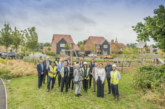Jan Taranczuk, Strategic Housing Advisor at fire suppression specialists Plumis, discusses what new fire safety rules will mean for social landlords.
New fire safety regulations are bringing in a raft of extra requirements and responsibilities for housing providers, in a bid to better protect residents living in high-rise blocks.
In addition to the Building Safety Act, the Government has introduced the Fire Safety (England) Regulations 2022 as part of its ongoing response to the Grenfell Tower tragedy and the resulting inquiry’s recommendations.
With the new regulations coming into force in January 2023, social landlords need to take stock of these latest reforms and the implications for their organisation.
Key changes
Crucial changes include:
- The need to provide residents with fire safety instructions and information about the importance of fire doors, in all multi-occupied residential buildings
- Annual checks of flat entrance doors and quarterly checks of all fire doors in communal areas, in residential buildings over 11 metres high
- Monthly inspections of lifts and firefighting equipment, along with the need to share information with fire and rescue services which will help them respond in case of a fire.
Housing providers must make sure they have plans in place to action these legislative changes. Perhaps most importantly, this should include a resident engagement strategy to ensure they are informing everyone about how to keep themselves and their neighbours safe.
The regular inspections of fire doors and firefighting equipment will need to be scheduled in, as well as robust processes to accurately record such checks, in order to demonstrate compliance with the regulations and promptly action any remedial work necessary.
Beware complacency
The new rules are to be welcomed as a further step forward in improving fire safety for residents living in high-rise flats. However, having implemented these changes, it is vital that housing association boards and leadership teams guard against complacency.
The Building Safety Act stipulates that, once the ‘accountable person’ has demonstrated that their high-rise residential building complies with the law, the Health and Safety Executive will issue a Building Assessment Certificate confirming that the property is safe for occupation.
But, while this certificate proves that steps have been taken to reduce the opportunity for a fire within the building to spread, these measures do nothing to actually reduce the risk of fires occurring in the first place.
Hence, as well as making these necessary changes, housing providers must also maintain continuous messaging to their residents (without becoming so repetitive it begins to be ignored) around fire prevention and safety awareness.
This messaging should also reflect a recognition of emerging fire safety challenges, such as the potential dangers posed by charging the UK’s growing number of electric bicycles, scooters and even cars.
Engaging with residents is key to the success of these legislative changes in achieving their life-saving aims. But change is a continuous cycle, so leadership teams need to constantly question and challenge in order to ensure their fire safety measures keep pace with the changing risks they seek to combat.
Header image ©Pixel-Shot/AdobeStock









